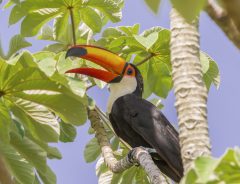When to go to Iguazu Falls – Argentinian side
December - February
Summer in Iguazú Falls is hot and humid, particularly in January. Due to plentiful rainfall, the falls are bursting full as they thunder dramatically through the rainforest, soaking onlookers with a refreshing spray. Some trails may be inaccessible and January - February are especially busy as it’s Latin American holiday time.
0°C Average max daytime temperature
0°C Average min nighttime temperature
0 days per season rainfall
humidity

March - May
There are fewer visitors during these months, with the exception of Easter week. From April onwards is the best time to spot a kaleidoscope of colourful butterflies and rainbows. Early mornings can be a little cold, creating good conditions for hiking or cycle rides in the area.
0°C Average max daytime temperature
0°C Average min nighttime temperature
0 days per season rainfall
humidity

June - August
Temperatures are at their coolest, particularly in the crisp early mornings. The climate is dry and the skies are often clear and sunny. The cooler temperatures make this a good time to hike or cycle through the subtropical rainforest.
0°C Average max daytime temperature
0°C Average min nighttime temperature
0 days per season rainfall
humidity

September - November
Following the dry winter season, water levels are reduced in the falls. Individual cataracts become visible as they plunge over granite cliffs. Weather conditions are pleasant, neither too hot and humid nor especially wet, though rainfall is always possible.
0°C Average max daytime temperature
0°C Average min nighttime temperature
0 days per season rainfall
humidity

Papagaio
Your edit for Latin American inspiration
Our exciting range of articles on Latin America explore everything from iconic destinations and lesser-known cultural gems to delicious traditional recipes. You’ll also find exclusive travel tips, first-hand client reviews and the chance to get your personal questions answered by our travel experts.
View Extraordinary Inspiration


































